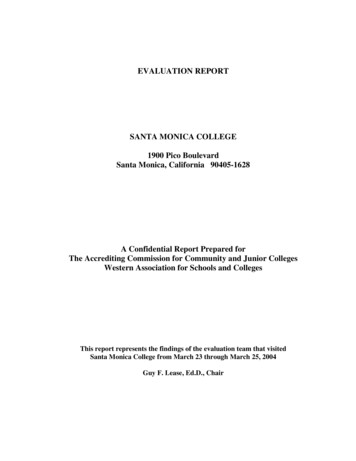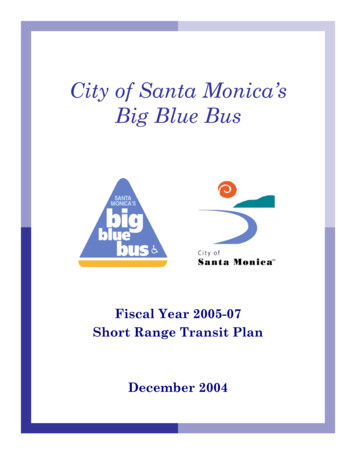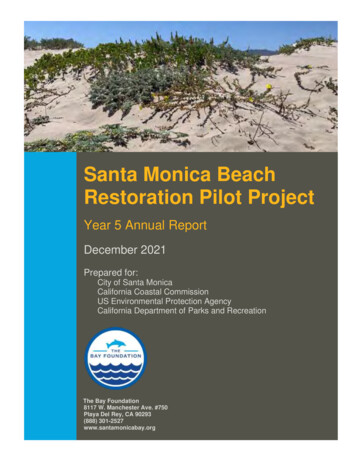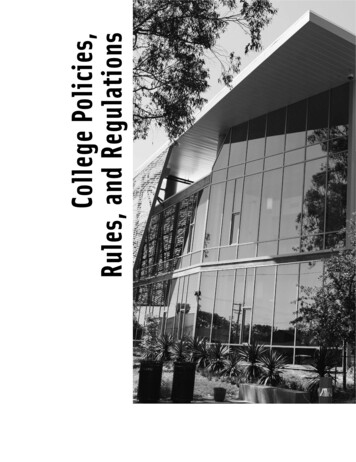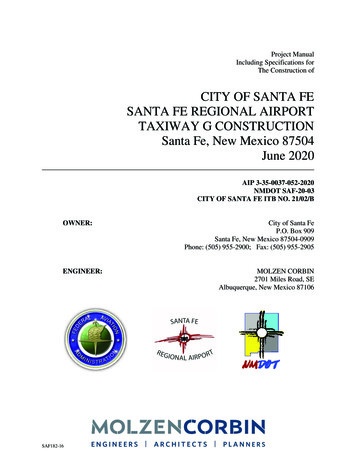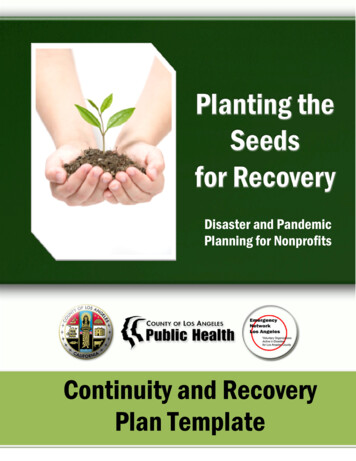
Transcription
Disaster and PandemicPlanning for NonprofitsContinuity and RecoveryPlan Template
This publication was supported by Grant Cooperative Agreement number 5U90TP917012-08 from the U.S. Centers forDisease Control and Prevention (CDC). Its contents are solely the responsibility of the authors and do not necessarilyrepresent the official views of the CDC.
InstructionsThe Business Continuity and Recovery Plan Template is intended to be used in addition to yourEmergency Preparedness and Response Plan. Some key differences between these plans are:Business Continuity and Recovery PlanThis plan is for use once life and safety are secure in response to a disaster. This plan identifieskey resources and needs to ensure that business may continue, perhaps in a limited capacity, orhow your nonprofit will fully recover should the disaster be catastrophic. This plan includesinformation such as: Critical assets Critical operations Key funders, donors and board members Alternate business locationEmergency Preparedness and Response PlanThis plan identifies and prioritizes the key hazards that may affect nonprofit operations, andoutlines preparedness and mitigation activities. This plan also includes operational procedures torespond effectively and efficiently to an incident. This goal of this procedure is to ensure life andsafety are secure in response to a disaster. This plan includes information such as: Preparednesso Hazard identification and assessmento Employee education and trainingo Drills and exercises timelines and plans for your businesso First aid kitso Disaster supply kits Responseo Evacuation procedureso Fire procedureso Shelter-in-place procedureso Staff notificationo Information gathering procedureso Incident managementContinuity Planning and the BusinessBusiness Impact AnalysisAnalysisAn integral part of continuity planning involves the completion of a Business impact analysis (BIA).The BIA is an essential component of an organization's business continuance plan; it includes anexploratory component to reveal any vulnerabilities, and a planning component to develop strategiesfor minimizing risk. The result of analysis is a report that describes the potential risks specific to theorganization studied. One of the basic assumptions behind a BIA is that every component of theorganization is reliant upon the continued functioning of every other component. Some componentsare more crucial than others and require a greater allocation of funds in the wake of a disaster. Forexample, an organization may be able to continue functioning normally if the cafeteria has to close,but would come to a complete halt if the information system crashes.As part of a disaster recovery plan, BIA is likely to identify costs linked to failures, such as loss ofcash flow, replacement of equipment, salaries paid to catch up with a backlog of work, loss offunding, and so on. A BIA report quantifies the importance of business components and suggestsappropriate fund allocation for measures to protect them. The possibilities of failures are likely to beassessed in terms of their impacts on safety, finances, marketing, legal compliance, and quality1 P a g e
assurance. Where possible, impact is expressed monetarily for purposes of comparison. Forexample, a business may spend three times as much on marketing in the wake of a disaster torebuild staff and community confidence.It is a best practice to conduct a BIA at the start of formal business continuity planning efforts.Templates, checklists and sample BIA materials have been included on your Disaster Planning forNonprofits Resource CD. These resources have been provided as tools for your organization onceyou formally begin the continuity process at your facility.Today’sToday’s WoWorkshopAt today’s workshop, follow the easy steps and include in this template as much information as youcan. Feel free to ask the facilitators questions about key concepts, or ask for tips and ideas. Whenyou return to your office, meet with your business continuity and recovery planning team. You maybe able to add more information to each of these sections. Feel free to personalize the tables toyour specific needs. The more detail you add, the better your plan will help you recover from adisaster.This plan is included on your Disaster Planning for Nonprofits Resource CD in an electronic format(MS Word) so that you may easily enter and update your information.This document is also available for download at the Los Angeles County Department of Public s.htm.2 P a g e
Stakeholder Risk Prioritization for Los Angeles CountyThe County of Los Angeles Hazard Mitigation Advisory Committee prioritized risk to the residents andproperty of the countyHigh Risk Priority Hazards Earthquake (natural) Wildland Urban Interface Fire (natural) Weapons of Mass Destruction (WMD) Terrorism (technological) Utility Loss (technological) Flood (natural) Drought (natural) Biological/Health (technological) Waste Water and Water (technological) Economic Disruption (technological) Data Telecommunications (technological) Civil Unrest (technological)Moderate Risk Priority Hazards Large Venue Fires (technological) Transportation Incidents, rail/air/pipeline (technological) Hazardous Materials (technological) Radiological Incident/Accident (technological) Special Events (technological) Dam Failure (technological) Landslides (natural) Transportation/loss of ability (technological) Explosion (technological) Severe Weather (natural)Low Rick Priority Hazards Biological/Agriculture (technological) Tsunami (natural) Sinkholes/subsidence (technological) Rise in Ground Water (natural) Mine Safety (technological) Volcano (natural) Tornados (natural)3 P a g e
Risk Assessment MatrixUsing your list of potential hazards and critical assets, you are now ready to begin to prioritize thingsand asses where your nonprofit is vulnerable to disruption. For each of the six categories, you willdecide the level of impact each of the hazards will have on your nonprofit.Before completing your Risk Assessment Matrix you need to understand the difference between thelevels of impact. Below the levels are discussed and listed in order of escalation. Negligible – limited to no business disruptions or property damage Marginal – a hindrance that may affect business operations without shutting down, you haveno minor damage, it may be an occurrence in the surrounding neighborhood Critical – temporary disruptions of business or major damage to the facility, impacts are tothe community Catastrophic – a disaster that affects entire regional community causing businessdisruptions and forces closure of building(s). This is an event of large proportions. It caninclude complete destruction, multiple injuries or deaths, and a regional event which meanslimited or no outside resources available for prolonged periods of time.The table on the following page will help you to determine and prioritize your nonprofit risks.General types of events are listed on the left side. There are additional spaces provided tocustomize for your nonprofit needs.Begin with the first listed disaster event, earthquake. Circle the number in each asset area to scorehow the hazard would likely impact your business. Complete the other rows then total your numbersfor both columns and rows.As the last step, prioritize which areas should be addressed first, based on highest vulnerability, andthen assign each column with your priority number 1-6.From: 7 Steps to an Earthquake Resilient Business, Earthquake Country Alliance, www.earthquakecountry.info/roots/4 P a g e
Risk Assessment MatrixType of Event /HazardImpact to Critical Business AssetsPeopleBuilding1 Negligible1 Negligible2 Marginal2 Marginal3 Critical3 Critical4 Catastrophic4 CatastrophicEquipment1 Negligible2 Marginal3 Critical4 CatastrophicData1 Negligible2 Marginal3 Critical4 CatastrophicInventory/Product1 Negligible2 Marginal3 Critical4 CatastrophicOperations1 Negligible2 Marginal3 Critical4 123412341234123412341234Total ScoreTotalsPriority5 P a g e
Step 1: About Your NonprofitPRIMARY NONPROFIT LOCATIONSECOND NONPROFIT LOCATIONNONPROFIT NAMENONPROFIT NAMESTREET ADDRESSSTREET ADDRESSCITY, STATE, ZIP CODECITY, STATE, ZIP CODETELEPHONE NUMBERTELEPHONE NUMBERPRIMARY POINT OF CONTACTCONTACTALTERNATE POINT OF CONTACTCONTACTPRIMARY EMERGENCY CONTACTALTERNATE EMERGENCY CONTACTTELEPHONE NUMBERTELEPHONE NUMBERALTERNATE TELEPHONE NUMBERALTERNATE TELEPHONE NUMBERE-MAIL ADDRESSE-MAIL ADDRESSEMERGENCY CONTACT INFORMATIONINFORMATION - DIAL 911 IN AN EMERGENCYEMERGENCYNON-EMERGENCY POLICEELECTRICITY PROVIDERNON-EMERGENCY FIREGAS PROVIDERINSURANCE PROVIDERWATER PROVIDERPOISON INFORMATION CENTERRAPE/VICTIM SERVICESOTHER (E.G., HAZARDOUS MATERIAL SPILL CLEANUP)OTHER (E.G., PROPERTY SECURITY)OTHER (E.G., IT SUPPORT CONTRACTOR)OTHER (E.G., BANK AGENT)OTHER (E.G., PROPERTY MANAGEMENT)OTHEROTHEROTHER
Step 2: Business Continuity and Recovery Planning TeamThe following people will participate in business continuity and recovery planning.NAMEPOSITIONEMAILCoordination with OthersThe following people from neighboring organizations, businesses and our building management willparticipate on our emergency planning ESSEMAILMeeting ScheduleThe emergency planning team will meet on a regular basis.DATELOCATIONTOPIC
Step 3: Potential HazardsThis information should be included in your Emergency Preparedness and Response Plan, howeverreiterating key potential hazards in your Business Continuity and Recovery Plan will help you focus onthe types of incidents from which you may need to recover. Make sure to look inside and outsideyour nonprofit as well as the surrounding community. Ask yourself questions like: How do I get inand out of the area? How do my staff, suppliers, and clients/constituents get in and out of the area?What should I be concerned with that could interrupt the nonprofit?The following disasters could impact our operations.EXTERNAL (earthquake, fire, power outage, flood, disease,disease, vandalism, etc.)INTERNAL (fire, flood, theft, data management,management, power outage, disease,disease, etc.)
Step 4: Critical AssetsIf these items are taken away, it would drastically affect or harm your nonprofit or cause a majordisruption to operations. What does your nonprofit need to operate?PEOPLE (employees, consumers,consumers, donors,donors, board members,members, clients/constituents, key volunteers, etc.)BUILDING (physical structure, storage unit, satellite office,office, main office, store front, capital lease,lease, etc.)COMPUTER EQUIPMENT (computers,computers, software, servers/network, specialty tools, copiers, etc.)DATA (documents, payroll, files, records, server backback-up tapes, etc.)INVENTORY/PRODUCT (stock, supplies, new materials, etc.)OPERATIONS (any disruptiondisruption to ops,ops, accounts receivable/payable, payroll, mail room, etc.)
Step 4: Critical Assets (continued).VALUABLE CONTENTS (religious artifacts,artifacts, valuable collectables,collectables, etc.)BOOKS AND RECORDS (vital recordsrecords,ds, payroll information, etc.)EQUIPMENT (HVAC, kitchen equipment, audio visual equipment,equipment, specialty tools, copiers, etc.)FURNITURE AND FIXTURESFIXTURES (office furniture,furniture, custom built furniture,furniture, auxiliary furniture, etc.)GROUNDS (custom decorations, outdoor equipment,equipment, signage,signage, etc.)OTHER (artwork, antiques,antiques, etc.)
Step 5: Critical OperationsIdentify operations that are critical for your nonprofit’s survival. Does your nonprofit provide servicescrucial to the incident response? How will you continue to perform these functions in a disastersituation? What operations are necessary to fulfill legal and financial obligations? Which arenecessary to maintain cash flow and reputation? What operations does your nonprofit provide toothers (i.e. shelter, day care, spiritual guidance, food, etc.)? In the event of a disaster will people becongregating at your location needing assistance?PROCEDURES TO RESTART OPERATION AFTER MINIMAL DISASTER IMPACT: If a disaster causesnegligible or marginal impact on operations, these procedures will help to restart the operation in thesame location.PROCEDURES TO COMPLETELY RESTORE OPERATION AFTER SIGNIFICANT DISASTER IMPACT: If adisaster causes critical or catastrophic impact on operations, these procedures will help to restorethe operation in the same location, an alternate location, or a new location.OPERATION:STAFF IN CHARGE (POSITION)STAFF IN CHARGE (NAME)KEY SUPPLIES/EQUIPMENTKEY SUPPLIERS/CONTRACTORSPROCEDURES TO RESTART OPERATION AFTER MINIMAL DISASTER IMPACTPROCEDURES TO COMPLETELY RESTORE OPERATION AFTER SIGNIFICANT DISASTER IMPACTOPERATION:STAFF IN CHARGE (POSITION)STAFF IN CHARGE (NAME)KEY SUPPLIES/EQUIPMENTKEY SUPPLIERS/CONTRACTORSPROCEDURES TO RESTART OPERATION AFTER MINIMAL DISASTER IMPACTPROCEDURES TO COMPLETELY RESTORE OPERATION AFTER SIGNIFICANT DISASTER IMPACT
Step 5: Critical Operations (continued)PROCEDURES TO RESTART OPERATION AFTER MINIMAL DISASTER IMPACT: If a disaster causesnegligible or marginal impact on operations, these procedures will help to restart the operation in thesame location.PROCEDURES TO COMPLETELY RESTORE OPERATION AFTER SIGNIFICANT DISASTER IMPACT: If adisaster causes critical or catastrophic impact on operations, these procedures will help to restorethe operation in the same location, an alternate location, or a new location.OPERATION:STAFF IN CHARGE (POSITION)STAFF IN CHARGE (NAME)KEY SUPPLIES/EQUIPMENTKEY SUPPLIERS/CONTRACTORSPROCEDURES TO RESTART OPERATION AFTER MINIMAL DISASTER IMPACTPROCEDURES TO COMPLETELY RESTORE OPERATION AFTER SIGNIFICANT DISASTER IMPACTOPERATION:STAFF IN CHARGE (POSITION)STAFF IN CHARGE (NAME)KEY SUPPLIES/EQUIPMENTKEY SUPPLIERS/CONTRACTORSPROCEDURES TO RESTART OPERATION AFTER MINIMAL DISASTER IMPACTPROCEDURES TO COMPLETELY RESTORE OPERATION AFTER SIGNIFICANT DISASTER IMPACT
Step 6: Key Organizations and BusinessesThe following is a list of organizations and businesses that are critical to maintaining business (i.e.vendors, suppliers, funders, etc.).ORGANIZATION NAME:STREET ADDRESSCONTACT NAMECITY, STATE, ZIP CODECONTACT TELEPHONE NUMBERTELEPHONE NUMBERFAX NUMBERCONTACT EMAILEMERGENCY TELEPHONEWEBSITEDOES THIS ORGANIZATION HAVE A CONTINUITY PLAN?MATERIAL/SERVICE PROVIDEDIf this organization experiences a disaster, we will obtain materials/services from the following:ORGANIZATION NAME:STREET ADDRESSCONTACT NAMECITY, STATE, ZIP CODECONTACT TELEPHONE NUMBERTELEPHONE NUMBERFAX NUMBERCONTACT EMAILEMERGENCY TELEPHONEWEBSITEDOES THIS ORGANIZATION HAVE A CONTINUITY PLAN?MATERIAL/SERVICE PROVIDEDIf this organizations experiences a disaster, we will obtain materials/services from the following:
Step 6: Key Organizations and Businesses (continued)ORGANIZATION NAME:STREET ADDRESSCONTACT NAMECITY, STATE, ZIP CODECONTACT TELEPHONE NUMBERTELEPHONE NUMBERFAX NUMBERCONTACT EMAILEMERGENCY TELEPHONEWEBSITEDOES THIS ORGANIZATION HAVE A CONTINUITY PLAN?MATERIAL/SERVICE PROVIDEDIf this company experiences a disaster, we will obtain materials/services from the following:ORGANIZATION NAME:STREET ADDRESSCONTACT NAMECITY, STATE, ZIP CODECONTACT TELEPHONE NUMBERTELEPHONE NUMBERFAX NUMBERCONTACT EMAILEMERGENCY TELEPHONEWEBSITEDOES THIS ORGANIZATION HAVE A CONTINUITY PLAN?MATERIAL/SERVICE PROVIDEDIf this company experiences a disaster, we will obtain materials/services from the following:
Step 7: Computer Inventory FormUse this form to: Log your computer hardware serial and model numbers. Attach a copy of your vendordocumentation to this document. Record the name of the company from which you purchased or leased this equipment andthe contact name to notify for your computer repairs.Make additional copies as needed. Keep one copy of this list in a secure place on your premisesand another in an off-site location.HARDWARE INVENTORYHARDWARE(CPU, MONITOR,PRINTER, KEYBOARD,MOUSE, HASEDCOMPANYPURCHASED ORLEASED FROMCOSTSERIAL / KEYNUMBERDISC ORDOWNLOADDATEPURCHASEDCOSTSOFTWARE INVENTORYINVENTORYNAME OFSOFTWAREVERSION
Step 8: Information Technology SecurityData security and backup should be an ongoing process, however, it is crucial before a disaster. Ifyou use a contractor for your IT support, they should be included in your business continuity andrecovery planning. Identify the records that are essential to perform your critical functions. Vitalrecords may include employee data, payroll, financial and insurance records, customer data, legaland lease documents. Are any impossible to re-create? Are copies stored offsite?DATA SECURITY AND BACKBACKCK-UPLEAD STAFF OR CONTRACTOREMERGENCY CONTACT TELEPHONEEMAILALTERNATE CONTACT TELEPHONEBACK-UP RECORDS ARE STORED ONSITE HEREBACK-UP RECORDS ARE STORED OFFSITE HEREVIRTUAL RECORDS ARE STORED HEREVIRTUAL BACK-UP CONTACTIF OUR VIRTUAL RECORDS ARE DESTROYED, WE WILL PROVIDE FOR CONTINUITY IN THE FOLLOWING WAYS:IT ASSET SECURITYLEAD STAFF OR CONTRACTOREMERGENCY CONTACT TELEPHONEEMAILALTERNATE CONTACT TELEPHONEKEY COMPUTER HARDWARETO PROTECT OUR COMPUTER HARDWARE, WE WILL:KEY COMPUTER SOFTWARETO PROTECT OUR COMPUTER SOFTWARE, WE WILL:IF OUR COMPUTERS ARE DESTROYED, WE WILL USE BACK-UP COMPUTERS AT THE FOLLOWING LOCATIONS:
Step 9: Alternate/Temporary LocationDetermine if it is possible to set up an alternate or temporary location if your primary site isunavailable. Would this site become your new primary site? Do you have multiple locations in whichyou can condense work operations? How much work can be done virtually? Does your nonprofithave options for relocation in the same park? Would a work-from-home strategy work for yourorganization? What pre-agreements would you need for these options?ALTERNATE LOCATIONSECOND ALTERNATE LOCATIONSTREET ADDRESSSTREET ADDRESSCITY, STATE, ZIP CODECITY, STATE, ZIP CODETELEPHONE NUMBERTELEPHONE NUMBERIS THERE A PRE-AGREEMENT IN PLACE?IS THERE A PRE-AGREEMENT IN PLACE?POINT OF CONTACTPOINT OF CONTACTCONTACT NAMECONTACT NAMETELEPHONE NUMBERALTERNATE NUMBERTELEPHONE NUMBERALTERNATE NUMBERE-MAIL ADDRESSE-MAIL ADDRESSSITE ASSESSMENTSITE ASSESSMENTNUMBER AND TYPE OF STAFF TO WORK HERENUMBER AND TYPE OF STAFF TO WORK HERESUPPLIES ALREADY IN PLACESUPPLIES ALREADY IN PLACESUPPLIES THAT WOULD BE NEEDEDSUPPLIES THAT WOULD BE NEEDEDTIME TO SET UP OPERATIONSTIME TO SET UP OPERATIONSLENGTH OF TIME TO STAY IN THIS SITELENGTH OF TIME TO STAY IN THIS SITEPOSSIBLE HAZARDS IN THE AREAPOSSIBLE HAZARDS IN THE AREANOTES:NOTES:
Step 10: Staff NotificationStaff should be regularly updated on business operational status including whether they shouldreport to work, what work conditions are like, alternate work sites and plans, plan triggers, etc.NOTIFICATIONSTAFF WILL BE NOTIFIED BY: PHONE TREE AUTOMATIC NOTIFICATION SYSTEM EMAIL BLAST OTHER:STAFF WILL RESPOND BY: CALLING IN TO LIVE PERSON CALLING AUTOMATIC RESPONSE SYSTEM EMAIL IN OTHER:STAFF MEMBER RESPONSIBLE FOR NOTIFICATIONTELEPHONE NUMBEREMAILRESPOND IN NUMERAUTO RESPONSE NUMBERPLAN TRIGGERNOTIFYING STAFF NAME:STREET ADDRESSEMERGENCY CONTACT NAMECITY, STATE, ZIP CODERELATIONSHIP TO EMPLOYEETELEPHONE NUMBERALTERNATE NUMBEREMAILCONTACT TELEPHONEALTERNATE TELEPHONECONTACT EMAILNOTIFYING STAFF NAME:STREET ADDRESSEMERGENCY CONTACT NAMECITY, STATE, ZIP CODERELATIONSHIP TO EMPLOYEETELEPHONE NUMBEREMAILALTERNATE NUMBERCONTACT TELEPHONECONTACT EMAILALTERNATE TELEPHONE
Step 10: Staff Notification (continued)STAFF NAME:STREET ADDRESSEMERGENCY CONTACT NAMECITY, STATE, ZIP CODERELATIONSHIP TO EMPLOYEETELEPHONE NUMBERALTERNATE NUMBEREMAILCONTACT TELEPHONEALTERNATE TELEPHONECONTACT EMAILSTAFF NAME:STREET ADDRESSEMERGENCY CONTACT NAMECITY, STATE, ZIP CODERELATIONSHIP TO EMPLOYEETELEPHONE NUMBERALTERNATE NUMBEREMAILCONTACT TELEPHONEALTERNATE TELEPHONECONTACT EMAILSTAFF NAME:STREET ADDRESSEMERGENCY CONTACT NAMECITY, STATE, ZIP CODERELATIONSHIP TO EMPLOYEETELEPHONE NUMBERALTERNATE NUMBEREMAILCONTACT TELEPHONEALTERNATE TELEPHONECONTACT EMAILSTAFF NAME:STREET ADDRESSEMERGENCY CONTACT NAMECITY, STATE, ZIP CODERELATIONSHIP TO EMPLOYEETELEPHONE NUMBEREMAILALTERNATE NUMBERCONTACT TELEPHONECONTACT EMAILALTERNATE TELEPHONE
Step 11: Key Nonprofit Contact NotificationKey Fundors/grantors, Donors, board members, clients/consumers and other key contacts shouldbe regularly updated on operational status such open hours, orders in progress, etc. This may bedone via your website, posting signs at your business, or contacting them individually.NOTIFICATIONKEY NONPROFIT CONTACTS WILL BE NOTIFIED BY: WEBSITE AUTOMATIC NOTIFICATION SYSTEM EMAIL BLAST SIGNAGE OTHER:STAFF MEMBER RESPONSIBLE FOR NOTIFICATIONTELEPHONE NUMBEREMAILORGANIZATION NAME:STREET ADDRESSCONTACT NAMECITY, STATE, ZIP CODECONTACT TELEPHONE NUMBERTELEPHONE NUMBERFAX NUMBERCONTACT EMAILEMERGENCY TELEPHONEWEBSITERELATIONSHIP TO OUR NONPROFITORGANIZATION NAME:STREET ADDRESSCONTACT NAMECITY, STATE, ZIP CODECONTACT TELEPHONE NUMBERTELEPHONE NUMBERFAX NUMBERCONTACT EMAILEMERGENCY TELEPHONEWEBSITERELATIONSHIP TO OUR NONPROFITORGANIZATION NAME:STREET ADDRESSCONTACT NAMECITY, STATE, ZIP CODECONTACT TELEPHONE NUMBERTELEPHONE NUMBERFAX NUMBERCONTACT EMAILEMERGENCY TELEPHONEWEBSITERELATIONSHIP TO OUR NONPROFIT
Step 11: Key Nonprofit Contact Notification (continued)ORGANIZATION NAME:STREET ADDRESSCONTACT NAMECITY, STATE, ZIP CODECONTACT TELEPHONE NUMBERTELEPHONE NUMBERFAX NUMBERCONTACT EMAILEMERGENCY TELEPHONEWEBSITERELATIONSHIP TO OUR NONPROFITORGANIZATION NAME:STREET ADDRESSCONTACT NAMECITY, STATE, ZIP CODECONTACT TELEPHONE NUMBERTELEPHONE NUMBERFAX NUMBERCONTACT EMAILEMERGENCY TELEPHONEWEBSITERELATIONSHIP TO OUR NONPROFITORGANIZATION NAME:STREET ADDRESSCONTACT NAMECITY, STATE, ZIP CODECONTACT TELEPHONE NUMBERTELEPHONE NUMBERFAX NUMBERCONTACT EMAILEMERGENCY TELEPHONEWEBSITERELATIONSHIP TO OUR NONPROFITORGANIZATION NAME:STREET ADDRESSCONTACT NAMECITY, STATE, ZIP CODECONTACT TELEPHONE NUMBERTELEPHONE NUMBERFAX NUMBERCONTACT EMAILEMERGENCY TELEPHONEWEBSITERELATIONSHIP TO OUR NONPROFIT
Step 12: Continuity of Management PlanYou can assume that not every key person will be readily available or physically at the facility after anemergency. Ensure that recovery decisions can be made without undue delay. If relevant, consultyour legal department regarding laws and corporate bylaws governing continuity of management.Establish procedures for: Assuring the chain of command Maintaining lines of succession for key personnelPOLICY STATEMENT REGARDINGREGARDING CONTINUITY OF MANAGEMENTLEADER NAME:STREET ADDRESSSUCCESOR NAMECITY, STATE, ZIP CODESUCCESOR TELEPHONE NUMBERTELEPHONE NUMBEREMERGENCY TELEPHONEEMAILSUCCESOR EMAILRELATIONSHIP TO LEADERLEADER NAME:STREET ADDRESSSUCCESOR NAMECITY, STATE, ZIP CODESUCCESOR TELEPHONE NUMBERTELEPHONE NUMBEREMERGENCY TELEPHONEEMAILSUCCESOR EMAILRELATIONSHIP TO LEADERLEADER NAME:STREET ADDRESSSUCCESOR NAMECITY, STATE, ZIP CODESUCCESOR TELEPHONE NUMBERTELEPHONE NUMBEREMAILEMERGENCY TELEPHONESUCCESOR EMAILRELATIONSHIP TO LEADER
Step 13: Insurance Coverage Discussion FormUse this form to discuss your insurance coverage with your agent. Having adequate coverage nowwill help you recover more rapidly from a catastrophe.INSURANCEINSURANCE AGENT:STREET ADDRESSCONTACT NAMECITY, STATE, ZIP CODECONTACT TELEPHONE NUMBERTELEPHONE NUMBERFAX NUMBERCONTACT EMERGENCY TELEPHONEEMERGENCY TELEPHONEWEBSITECONTACT EMAILINSURANCE POLICY INFORMATIONINFORMATIONTYPE OFINSURANCEPOLICY NUMBERDEDUCTIBLESPOLICY LIMITSCOVERAGE(GENERALDESCRIPTION)DISASTER RELATED INSURANCEINSURANCE QUESTIONSDo you need Flood Insurance? YesWhat perils or causes of loss does my policy cover? NoDo you need Earthquake Insurance? Yes NoHow will my property be valued?Do you need Business Income and Extra ExpenseInsurance? Yes NoDoes my policy cover the cost of required upgrades tocode? Yes NoHow much insurance am I required to carry to avoidbecoming a co-insurer?What does my policy require me to do in the event ofa loss?What types of records and documentation will myinsurance company want to see?How will my emergency management program affectmy rates?Am I covered for lost income in the event of businessinterruption because of a loss? Do I have enoughcoverage? For how long is coverage provided? Howlong is my coverage for lost income if my business isclosed by order of a civil authority?To what extent am I covered for loss due tointerruption of power? Is coverage provided for bothon- and off-premises power interruption?To what extent am I covered for reduced income dueto customers' not all immediately coming back oncethe business reopens?NOTES
Constant and Associates, Inc.info@constantassociates.com
The Business Continuity and Recovery Plan Template is intended to be used in addition to your Emergency Preparedness and Response Plan. Some key differences between these plans are: Business Continuity and Recovery PlanBusiness Continuity and Recovery Plan This plan is for use once life and safety are secure in response to a disaster.


